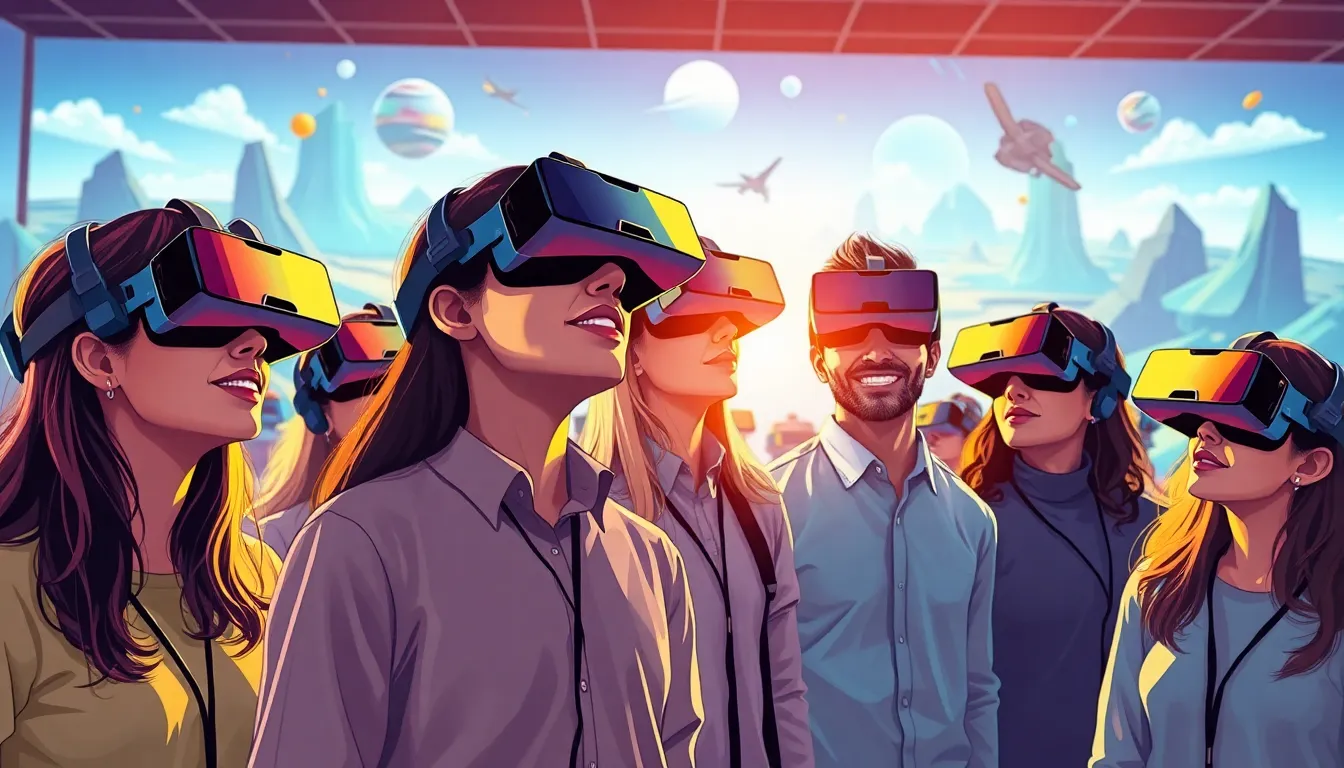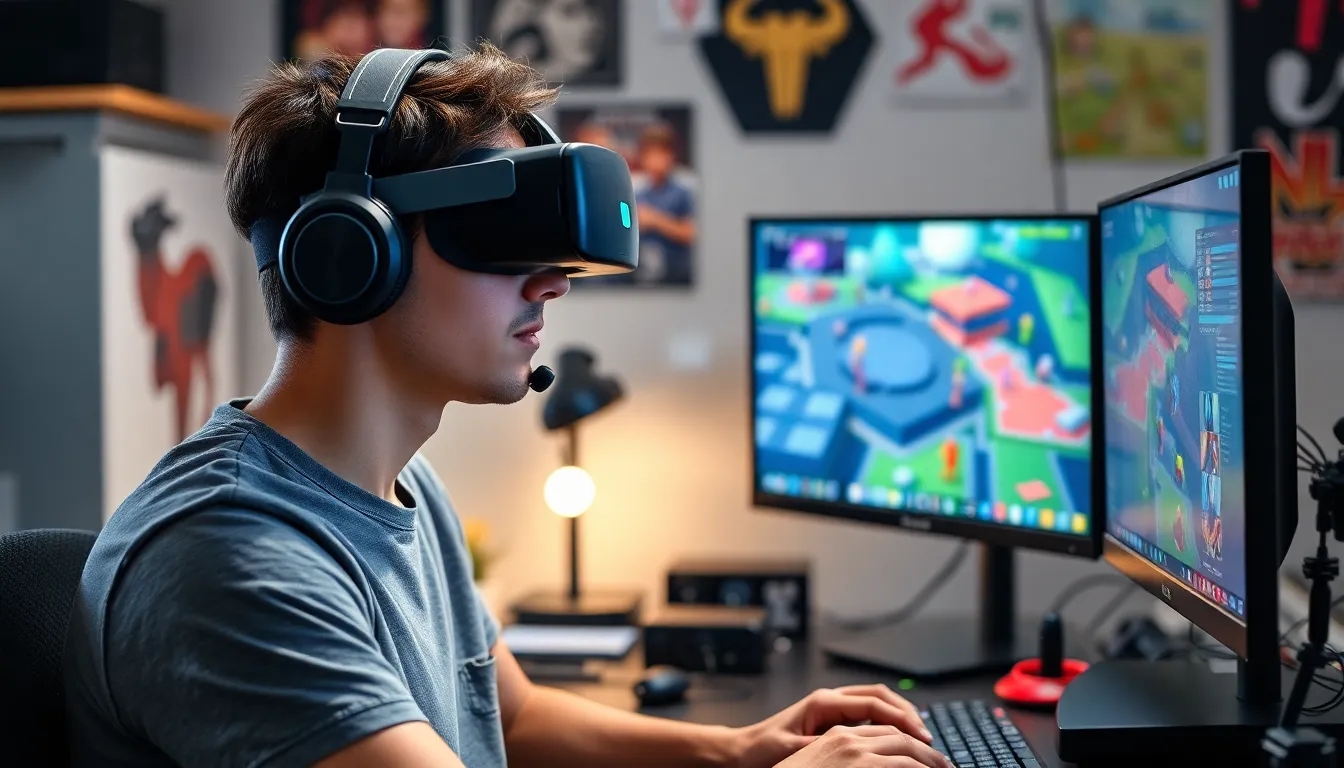In a world where reality often feels overrated, the metaverse is stepping in like a superhero with a cape made of pixels. Imagine a realm where your wildest gaming dreams come to life, and you can finally be that dragon-slaying wizard or a space-faring pirate you always wanted to be. Metaverse game development isn’t just a trend; it’s the future of interactive entertainment, where creativity knows no bounds and the only limit is your imagination.
As developers dive into this digital playground, they’re crafting experiences that blend gaming, social interaction, and commerce like never before. With virtual worlds expanding faster than a cat meme on the internet, there’s never been a better time to explore the exciting possibilities of metaverse game development. So grab your virtual gear and get ready to discover how this innovative field is reshaping the way we play and connect.
Metaverse Game Development
Metaverse game development represents a new frontier in the gaming industry, combining immersive experiences with social interaction. It shapes the future of interactive entertainment by blending technology, creativity, and community engagement.
Definition of the Metaverse
The metaverse encompasses interconnected virtual environments where users can interact in real time. It’s a shared digital space, integrating augmented reality (AR), virtual reality (VR), and traditional online gaming. This expansive universe allows players to create avatars, build unique worlds, and engage in diverse activities, fostering a sense of presence and belonging.
Importance of Game Development in the Metaverse
Game development in the metaverse plays a critical role in determining user engagement and experience. Engaging game mechanics and innovative content attract players to these expansive environments. Social features enhance collaboration and competition, while an open economy enables real-world transactions. Developers must prioritize user-generated content, ensuring players feel empowered to shape their experiences.
Key Technologies in Metaverse Game Development

Metaverse game development leverages various cutting-edge technologies that facilitate immersive and interactive experiences. Here’s a look at some key components driving this virtual frontier.
Virtual Reality (VR)
Virtual reality creates fully immersive environments where players can interact as if they were physically present. Headsets like Oculus Quest and HTC Vive offer high-quality graphics and responsive controls. Developers utilize VR to enhance player engagement, enabling seamless exploration of expansive worlds. In this realm, users experience heightened feelings of presence. Games developed for VR often incorporate gesture controls to facilitate natural interactions. Popular titles such as “Beat Saber” showcase the potential of this technology.
Augmented Reality (AR)
Augmented reality enhances the real world with digital overlays, allowing users to engage with virtual elements in their physical environment. AR applications, like “Pokémon GO,” demonstrate how the technology combines gameplay with real-world exploration. Developers rely on AR to create social engagements, merging community interactions with gaming. This blend encourages users to participate in activities beyond screen boundaries. Innovative AR tools, including ARKit and ARCore, enable developers to integrate interactive layers into everyday settings.
Blockchain Integration
Blockchain technology introduces decentralized systems that transform ownership and transactions in the metaverse. It allows players to own in-game assets as non-fungible tokens (NFTs), promoting a player-driven economy. Transparency and security become fundamental aspects of this integration, ensuring players can trade assets confidently. Developers incorporate smart contracts to automate transactions, enhancing user experience. Games such as “Axie Infinity” capitalize on blockchain to enable real ownership and economic opportunities for players.
Design Principles for Metaverse Games
Designing games for the metaverse requires a focus on core principles that enhance player engagement and creativity. Developing engaging experiences entails a deep understanding of user expectations and technological capabilities.
Immersive Environments
Creating immersive environments is fundamental in metaverse game development. Dynamic worlds invite players to explore rich landscapes and intricate details, which enhance their sense of presence. Developers leverage advanced graphics technology and realistic physics to build unforgettable spaces. Integrating audio elements amplifies this realism, making experiences more captivating. Incorporating elements from both fantasy and realism allows players to connect emotionally with their surroundings, enriching gameplay. Avatars that interact with these environments add depth, fostering a profound feeling of immersion.
User Interaction and Experience
User interaction in metaverse games shapes the overall experience significantly. Prioritizing social features enables collaboration, fostering connections among players. Designing intuitive controls allows seamless navigation, enhancing engagement. Implementing feedback systems encourages players to influence game scenarios, heightening their sense of agency. Encouragement of user-generated content empowers players to craft their own narratives, deepening their investment. Accessibility across various devices ensures a wider audience, promoting inclusivity and participation. The synergy created through these interactive elements elevates the overall game experience, making it memorable and inviting.
Challenges in Metaverse Game Development
Metaverse game development presents various challenges that developers must navigate creatively and strategically.
Technical Limitations
Technical limitations represent a significant hurdle. High-performance requirements for immersive experiences often outpace existing hardware capabilities. Developers frequently encounter issues with latency, which affects real-time interactions and gameplay fluidity. Scalability presents another concern, as virtual environments must support numerous concurrent users without compromising performance. Integration of diverse technologies, such as AR and VR, adds complexity, requiring robust systems for seamless interactions. Developers also face compatibility challenges across various devices, making it essential to optimize experiences for all platforms.
User Engagement
User engagement remains a critical focus. Creating compelling narratives and interactive gameplay encourages players to invest time and resources. Social dynamics influence how users connect and communicate within the game, with features like customizable avatars and in-game events fostering a sense of community. Developers prioritize accessibility, ensuring that experiences appeal to diverse audiences and skill levels. Regular updates and new content sustain interest and encourage user retention, yet managing creative resource demands can be challenging.
Monetization Strategies
Developers explore innovative monetization strategies to ensure financial viability. Microtransactions, in-game purchases, and subscription models often generate revenue, but they risk alienating players if not implemented thoughtfully. Non-fungible tokens (NFTs) present a unique monetization avenue, enabling players to buy, sell, or trade digital assets. Balancing monetization with user experience is essential; overly aggressive tactics can deter engagement. Collaborations with brands and sponsorships offer additional revenue streams while enhancing game integration and authenticity.
Conclusion
The metaverse is redefining the gaming landscape in ways previously thought impossible. As developers embrace this innovative frontier they’re not just creating games but entire worlds filled with opportunities for interaction and creativity. The combination of immersive technologies and user-generated content is fostering a vibrant community where players can truly belong.
While challenges exist in the realm of metaverse game development the potential rewards are immense. By prioritizing engaging experiences and innovative design principles developers can captivate audiences and pave the way for the future of interactive entertainment. As this digital universe continues to evolve it promises to reshape how players connect and experience gaming on a global scale.




